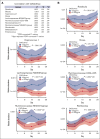Changes in gut microbiota predict neutropenia after induction treatment in childhood acute lymphoblastic leukemia
- PMID: 39561377
- PMCID: PMC11985026
- DOI: 10.1182/bloodadvances.2024013986
Changes in gut microbiota predict neutropenia after induction treatment in childhood acute lymphoblastic leukemia
Abstract
Delayed neutrophil recovery during acute lymphoblastic leukemia (ALL) treatment increases the risk of infection and causes delay in chemotherapy. Emerging evidence implicates gut microbiota in neutrophil reconstitution after chemotherapy. We explored the interplay between the gut microbiota and neutrophil dynamics, including neutrophil chemoattractants, in 51 children with newly diagnosed ALL. Daily absolute neutrophil count (ANC), weekly plasma chemokines (CXCL1 and CXCL8), granulocyte colony-stimulating factor (G-CSF), and fecal samples were monitored until day 29 during ALL induction treatment. Fecal sequencing using 16S ribosomal RNA revealed an overall significant reduction in bacterial diversity and Enterococcus overgrowth throughout the induction treatment. Prolonged neutropenia (ANC <0.5 × 109 cells per L at day 36) and elevated chemokine levels were associated with a decreased abundance of genera from the Ruminococcaceae and Lachnospiraceae families, decreased Veillonella genus, and Enterococcus overgrowth from diagnosis and throughout induction treatment. G-CSF was upregulated in response to neutropenia but was unrelated to microbiota changes. Overall, this study revealed that a diminished abundance of specific intestinal commensals and Enterococcus overgrowth is associated with delayed neutrophil reconstitution and increased chemokine signaling, indicating that disruption of the microbiota may contribute to prolonged neutropenia. These findings lay the groundwork for future investigations into the mechanisms underlying these associations and their clinical implications for developing gut-sparring strategies to minimize the impact of gut dysbiosis on immune recovery.
© 2025 American Society of Hematology. Published by Elsevier Inc. Licensed under Creative Commons Attribution-NonCommercial-NoDerivatives 4.0 International (CC BY-NC-ND 4.0), permitting only noncommercial, nonderivative use with attribution. All other rights reserved.
Conflict of interest statement
Conflict-of-interest disclosure: The authors declare no competing financial interests.
Figures







Similar articles
-
Gastrointestinal toxicity during induction treatment for childhood acute lymphoblastic leukemia: The impact of the gut microbiota.Int J Cancer. 2020 Oct 1;147(7):1953-1962. doi: 10.1002/ijc.32942. Epub 2020 Mar 16. Int J Cancer. 2020. PMID: 32115690
-
Gut Microbiome Composition Predicts Infection Risk During Chemotherapy in Children With Acute Lymphoblastic Leukemia.Clin Infect Dis. 2018 Aug 1;67(4):541-548. doi: 10.1093/cid/ciy153. Clin Infect Dis. 2018. PMID: 29518185 Free PMC article. Clinical Trial.
-
The clinical impact of primary granulocyte-colony stimulating factor prophylaxis in children with acute lymphoblastic leukemia who underwent induction chemotherapy.J Microbiol Immunol Infect. 2024 Dec;57(6):879-886. doi: 10.1016/j.jmii.2024.08.004. Epub 2024 Aug 20. J Microbiol Immunol Infect. 2024. PMID: 39198047
-
The effect of granulocyte colony-stimulating factors on survival parameters in pediatric patients with acute lymphoblastic leukemia: A retrospective study.Transfus Apher Sci. 2022 Feb;61(1):103366. doi: 10.1016/j.transci.2022.103366. Epub 2022 Jan 25. Transfus Apher Sci. 2022. PMID: 35120829 Review.
-
A gut instinct for childhood leukemia prevention: microbiome-targeting recommendations aimed at parents and caregivers.Front Public Health. 2025 Jan 13;12:1445113. doi: 10.3389/fpubh.2024.1445113. eCollection 2024. Front Public Health. 2025. PMID: 39872101 Free PMC article. Review.
Cited by
-
Role of gut microbiota in predicting chemotherapy-induced neutropenia duration in leukemia patients.Front Microbiol. 2025 Mar 19;16:1507336. doi: 10.3389/fmicb.2025.1507336. eCollection 2025. Front Microbiol. 2025. PMID: 40177485 Free PMC article.
-
A Literature Review on the Impact of the Gut Microbiome on Cancer Treatment Efficacy, Disease Evolution and Toxicity: The Implications for Hematological Malignancies.J Clin Med. 2025 Apr 25;14(9):2982. doi: 10.3390/jcm14092982. J Clin Med. 2025. PMID: 40364013 Free PMC article. Review.
-
Microbiome Modulation in Pediatric Leukemia: Impact on Graft-Versus-Host Disease and Treatment Outcomes: A Narrative Review.Children (Basel). 2025 Jan 29;12(2):166. doi: 10.3390/children12020166. Children (Basel). 2025. PMID: 40003268 Free PMC article. Review.
References
-
- Schmiegelow K, Forestier E, Hellebostad M, et al. Long-term results of NOPHO ALL-92 and ALL-2000 studies of childhood acute lymphoblastic leukemia. Leukemia. 2010;24(2):345–354. - PubMed
-
- Afzal S, Ethier MC, Dupuis LL, et al. Risk factors for infection-related outcomes during induction therapy for childhood acute lymphoblastic leukemia. Pediatr Infect Dis J. 2009;28(12):1064–1068. - PubMed
-
- Kolaczkowska E, Kubes P. Neutrophil recruitment and function in health and inflammation. Nat Rev Immunol. 2013;13(3):159–175. - PubMed
-
- Balmer ML, Schürch CM, Saito Y, et al. Microbiota-derived compounds drive steady-state granulopoiesis via MyD88/TICAM signaling. J Immunol. 2014;193(10):5273–5283. - PubMed
MeSH terms
Substances
LinkOut - more resources
Full Text Sources

